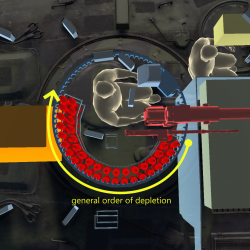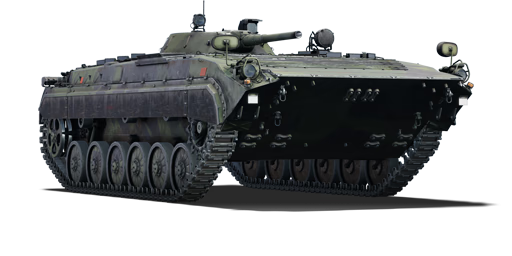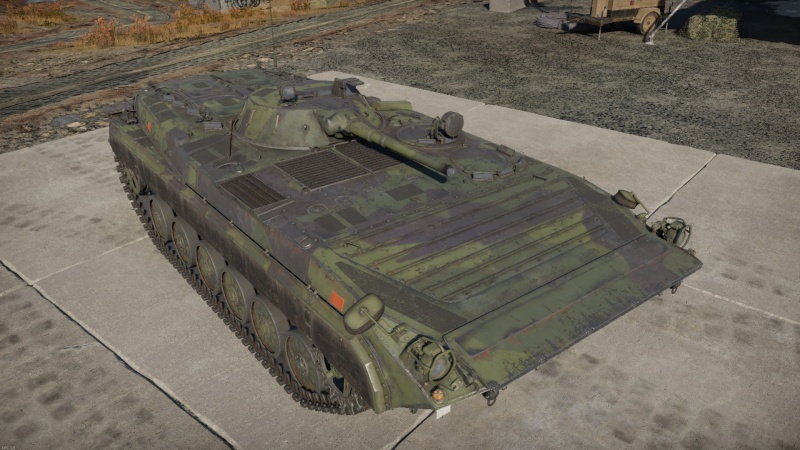Difference between revisions of "Pbv 501"
m (added armor values) |
Colok76286 (talk | contribs) (Undo revision 191913 by U154342554 (talk)) |
| (One intermediate revision by one other user not shown) | |
(No difference)
| |
Latest revision as of 02:27, 5 September 2024
Contents
Description
The Pansarbandvagn 501 was the Swedish designation for the BMP-1, acquired from Germany after the fall of the Soviet Union. In defense decisions 92, Sweden wanted to invest a portion of the military funding to mechanized infantry, during this decision they decided to buy 433 vehicles of different BMP-1 models. These Pbv 501 were sent to the Czech Republic to be modified to Swedish standards and would be used until 2010, when the Pbv 501 were sold to the Czech Republic which later sold them to Iraq.
The Pbv 501 was introduced in Update "Kings of Battle". Compared to other BMP-1s, it lacks the ATGMs most BMP vehicles are equipped with in-game, decreasing the vehicle's effectiveness at long range. However, it is still equipped with its 73 mm 2A28 gun, a familiar weapon for those who are experienced with the BMP-1. Its thin armor leaves much to be desired, but its autoloaded gun and good mobility make it a good brawler in close range engagements.
General info
Survivability and armour
Describe armour protection. Note the most well protected and key weak areas. Appreciate the layout of modules as well as the number and location of crew members. Is the level of armour protection sufficient, is the placement of modules helpful for survival in combat? If necessary use a visual template to indicate the most secure and weak zones of the armour.
Armour type:
| Armour | Front (Slope angle) | Sides | Rear | Roof |
|---|---|---|---|---|
| Hull | 7-12 mm (80°) Front glacis 19 mm (56°) Lower glacis |
16 mm (3-18°) Top 18 + 4 mm Bottom |
16 mm (12°) Top 12 mm (48°) Bottom 12 mm (8-51°) Doors |
6 mm 5 mm Engine exhausts |
| Turret | 23 mm (0-53°) Turret front 33 + 26 mm Gun mantlet |
13-23 mm (24-37°) | 13 mm (23-26°) | 6 mm |
| Cupola | 7 mm | 7 mm | 7 mm | 7 mm |
Notes:
Mobility
Write about the mobility of the ground vehicle. Estimate the specific power and manoeuvrability, as well as the maximum speed forwards and backwards.
| Game Mode | Max Speed (km/h) | Weight (tons) | Engine power (horsepower) | Power-to-weight ratio (hp/ton) | |||
|---|---|---|---|---|---|---|---|
| Forward | Reverse | Stock | Upgraded | Stock | Upgraded | ||
| Arcade | 73 | 12 | 11.9 | 465 | 572 | 39.08 | 48.07 |
| Realistic | 66 | 11 | 265 | 300 | 22.27 | 25.21 | |
Modifications and economy
Armaments
Main armament
Just like the BMP-1, the Pbv 501 is armed with the 2A28 main cannon. However, it lacks an ATGM launcher compared to the BMP-1, which decreases the vehicle's long range engagement capabilities.
The PG-9 HEAT will be your primary choice of ammunition in combat. Capable of penetrating up to 300 mm of armour, a well placed shot fired at the enemy tanks will usually result in most critical components being damaged if not destroyed. However, care must be taken as the Pbv 501 lacks any sort of stabilizer, which severely reduces the chances of hitting a target while going full speed. The vehicle comes equipped with a cruise control setting of CC BATTLE, however, which keeps the gun stable albeit at a very low (around 3-4kph) moving speed - something that may let you get an accurate shot off in certain situations.
The OG-9 HE is best left ignored. The PG-9 HEAT shell mentioned above has actual armor penetration while the OG-9 does not, and also overpressures light vehicles on a decently placed hit. As open top vehicles start becoming less and less common on the battlefield, OG-9 is simply irrelevant and there is very little reason to take the shell over its HEAT counterpart.
The cannon is equipped with an autoloader, allowing for a consistent 6 second reload. As this tank lacks ATGMs, the turret speed compared to the BMP-1 has been slightly improved. However, the cannon has a few shortcomings that may necessitate some player compensation. First off, the ballistic performance of the rounds are fairly mediocre, at 665 m/s for the PG-9 HEAT and 290 m/s for the OG-9 HE, making long range shots a challenge if the player is inexperienced with the gun's ballistics. Second, the gun depression is limited to only -4°, similar to other Russian tanks in the Swedish Tech Tree. This will make a change of play-style necessary, as most Swedish tanks have good gun depression and can frequently use terrain features almost no other nations can utilize.
| 73 mm 2A28 | Turret rotation speed (°/s) | Reloading rate (seconds) | ||||||||
|---|---|---|---|---|---|---|---|---|---|---|
| Mode | Capacity | Vertical | Horizontal | Stabilizer | Stock | Upgraded | Full | Expert | Aced | Autoloader |
| Arcade | 40 | -4°/+30° | ±180° | - | 19.0 | 26.4 | 32.0 | 35.4 | 37.6 | 6.00 |
| Realistic | 11.9 | 14.0 | 17.0 | 18.8 | 20.0 | |||||
Ammunition
| Penetration statistics | |||||||
|---|---|---|---|---|---|---|---|
| Ammunition | Type of warhead |
Penetration @ 0° Angle of Attack (mm) | |||||
| 10 m | 100 m | 500 m | 1,000 m | 1,500 m | 2,000 m | ||
| PG-9 | HEAT | 300 | 300 | 300 | 300 | 300 | 300 |
| OG-9 | HE | 11 | 11 | 11 | 11 | 11 | 11 |
| Shell details | ||||||||||||
|---|---|---|---|---|---|---|---|---|---|---|---|---|
| Ammunition | Type of warhead |
Velocity (m/s) |
Projectile mass (kg) |
Fuse delay (m) |
Fuse sensitivity (mm) |
Explosive mass (TNT equivalent) (g) |
Ricochet | |||||
| 0% | 50% | 100% | ||||||||||
| PG-9 | HEAT | 665 | 2.6 | 0 | 0.01 | 918.75 | 65° | 72° | 77° | |||
| OG-9 | HE | 290 | 3.7 | 0.05 | 0.1 | 735 | 79° | 80° | 81° | |||
Ammo racks

| Full ammo |
1st rack empty |
Visual discrepancy |
|---|---|---|
| 40 | 1 (+39) | No |
The single ammunition rack consists of a shell chamber located around the turret basket.
Machine guns
Offensive and anti-aircraft machine guns not only allow you to fight some aircraft but also are effective against lightly armoured vehicles. Evaluate machine guns and give recommendations on its use.
| 7.62 mm PKT | ||||
|---|---|---|---|---|
| Mount | Capacity (Belt) | Fire rate | Vertical | Horizontal |
| Coaxial | 2,000 (1,000) | 700 | - | - |
Usage in battles
The Pbv 501 is in essence a BMP-1 stripped of its ATGM armament. To some this may seem like an unacceptable downgrade - the 4 missiles the BMP-1 carries have good explosive mass, speed and let the vehicle engage far away targets effectively, and this is a valid point. However, the Pbv 501 makes up for it by having a full 1 BR lower placement than the regular BMP-1, and still retains the 2A38 73mm cannon. The 2A38 is an acquired taste; To those who don't like the low velocity and sometimes middling damage, the gun is a lackluster weapon, while to those who know the ballistics it can be a surprisingly effective cannon with a good reload rate.
Most of the Pbv 501's uses will be in urban combat. The vehicle lacks the weaponry to handle long range engagements, and even with good aim at the helm the lacking muzzle velocity and inability to use terrain hamper the vehicle's long range capabilities. At close range, however, these are less of a concern, and the fairly low profile and punchy, moderately fast reloading cannon serve the vehicle well. As the gun isn't an autocannon it has the raw punching power to knock out components more consistently, and the overall damage isn't too bad either. As Sweden's other vehicles generally excel at long range but lack close range advantages like the Ikv 91 or VIDAR, the Pbv 501 can add some valuable brawling capabilities (albeit as a glass cannon) to the lineup.
Pros and cons
Pros:
- Low silhouette
- Punchy gun with an autoloader
- High power-to-weight ratio and quick acceleration
- Excels at urban brawling, something Swedish vehicles generally aren't suited for
- Has access to scouting
Cons:
- No ATGMs unlike other BMP-1s
- Thin armour
- Lacking gun depression of -4 compared to the common -10 or more on other contemporary Swedish vehicles
- Poor cannon ballistics
- Sometimes has inconsistent spalling
History
Development
As one of the most ubiquitous infantry fighting vehicles of the Cold War, the Soviet BMP-1 remained in service with many ex-Eastern Bloc states after the collapse of the Warsaw Pact. Several of those ex-Eastern Bloc states, along with their arsenals, approached the Western Bloc. Most notably, following German reunification in 1990, the freshly unified Federal Republic of Germany inherited large weapon and vehicle stocks that used to belong to East Germany (the GDR). This included over a thousand Czechoslovakian-built BMP-1s. A local upgrade programme was carried out to "westernise" those BMPs to NATO standards starting in December 1990. This resulted in the BMP-1A1 Ost, which forfeited its guided missile armament, had toxic asbestos removed from the vehicle, added standard German Army headlights, rear lights, wing mirrors and the typical Leitkreuz low-light identification markings. 580 BMP-1s were converted to BMP-1A1 Ost standard between 1991 and 1993. 500 of those were sold to Greece in 1994, but the 80 modernised, as well as hundreds of unmodernised ones, remained in German stocks.
BMP-1 in Sweden
Sweden at the time was facing the dilemma of the state-of-the-art CV90 not yet being available in large numbers and the in-service Pbv 302 being significantly outdated. Thus, eager to purchase infantry fighting vehicles at a good price, and Germany providing just that in the form of hundreds of BMP-1s, Sweden approached Germany in early 1994 with the interest of purchasing five vehicles for trial runs. Of those five BMP-1s, one was used in ballistic trials to gauge the protection levels of the vehicle. The others were given Swedish registration numbers and named after famous WWII commanders: 204992 'Patton', 204994 'Monty', 204997 'Rommel', and 204998 'Guderian'. The trials did not last long. It was realised that the BMP-1 was difficult to adapt to Western standards, as the Germans already realised during their BMP-1A1 Ost programme. If Sweden were to purchase BMP-1s, some of which would be in their original state, it was clear that an indigenous upgrade programme would have to be devised. The BMP-1 nonetheless possessed valuable qualities in the eyes of the Swedish Army. It was highly mobile, especially due to its amphibious capabilities, and was considered to equip the Norrland brigades operating in northern Sweden, specialising in sub-arctic warfare. At the same time, Sweden was looking at the MT-LB multipurpose armoured vehicle, which was destined to equip units in southern Sweden. In June of 1994, Sweden decided to formally purchase 350 BMP-1s and an additional 83 for spare parts. In total, 433 BMP-1s were delivered, comprising 81 BMP-1A1 Ost, 60 BMP-1P with the 9K113 Konkurs missile, and 292 unupgraded BMP-1s. The cost was minuscule, at 33,000 DM (~=17,000 EUR or 19,000 USD) a piece, or a tenth of the price of a new Bv 206 articulated vehicle. This was because Germany was quite eager to get rid of the BMP-1s due to new military restrictions and to regain the cost of the BMP-1A1 Ost programme. The Swedish Army then contracted repair workshop VOP-026 in the Czech Republic to overhaul the BMPs for Swedish service. Delivery of those modernised BMP-1s would begin in 1996 at twelve a month. In Swedish service, they would become known as the Pbv 501. They were painted either in green or a bicolour green-black scheme.
The core of modifications consisted of small changes in ergonomics and safety standards. First, asbestos would be removed, which was found in the BMP-1 brake and clutch linings. Externally, new NATO standard lighting was fitted, as well as indicators to safely drive on roads. The exhaust pipe was redesigned, and anti-slip patches added to the outside of the vehicle to make it easier for soldiers to climb onto and around. An easy way to identify a Pbv 501 from a BMP-1 is the rectangular box on the left of the turret, which is a protective cap over the outlets and inlets of the ventilation system. Internally, a heating system was added, in addition to a fire detection and extinction system. The batteries were moved and isolated from the crew compartment. Covers were added around the viewports so that dismounts would not get caught or hurt themselves on sharp corners. The small arms holders were modified to hold the standard Swedish Ak-5 assault rifle. As far as concerns the main armament, the autoloader for the 73 mm 2A28 was removed entirely, as was the mounting rail for the 9M14 Malyutka guided missile. A safety mechanism was also installed that meant that the 73 mm gun and the 7.62 mm PKT machine gun could not be operated while the hatches were open. These modifications turned the Pbv 501 into arguably the least capable variant of the BMP-1, yet this was not deemed an issue by the Swedish Army. The intent was not to use the BMP-1 in numbers on a future battlefield, but to prepare the units for the operation of a dedicated IFV, namely the vastly more capable Strf 9040.
Service
In Swedish service, the vehicles' mobility, while satisfactory, struggled in deeper snow, to the point where it was judged unsuitable to be fielded by the Norrland brigades. Because of this, the initial plan to equip northern units with Pbv 501 and southern units with the MT-LB (Pbv 401) was reversed, with Pbv 501 now going to the 2nd, 4th and 12th infantry brigades of the Swedish Army in the south of the country. They were used by the following units:
- Värmland brigade (IB 2) in Kristinehamn
- Livgrenadjär brigade (IB 4) in Linköping
- Småland brigade (IB 12) in Eksjö
- Halland brigade (IB 16) in Halmstad
- Land Warfare Centre (Markstridsskolan) in Borensberg
Furthermore, it was also discovered that when firing the 73 mm cannon, a not insignificant amount of nitrocellulose would be discharged into the air, which was deemed potentially harmful to the crew. This seemed to have been an issue mostly with the PG-15V HEAT round. As such, Sweden did not purchase a stockpile of PG-15 HEAT ammunition, meaning that if Pbv 501 were ever to see combat, it would have practically no means at all to combat any form of enemy armour. On the plus side, the vehicle was considered mechanically very reliable. However, if an issue arose, especially in the engine block, its removal and replacement was a tedious process that took about 10 times longer than on the Strf 9040. The radios were also found to be of poor quality, with inferior transmission quality and range compared to Swedish models. In 2005, the decision was taken to retire the Pbv 501. The entire fleet was sold back to a Czech company called EXCALIBUR (who now also owned repair workshop VOP-026) for 30 million SEK (6 million USD). In 2015, EXCALIBUR found a buyer in the form of Iraq with as many as 250 vehicles being estimated to have been bought by Iraq. In April 2022, the German government approved the resale of 56 Pbv 501 from Czechia to Ukraine.
Media
- Skins
See also
Links to the articles on the War Thunder Wiki that you think will be useful for the reader, for example:
- reference to the series of the vehicles;
- links to approximate analogues of other nations and research trees.
External links
| Sweden light tanks | |
|---|---|
| L-60 | Strv m/38 · Strv m/39 · Strv m/39 TD · Strv m/40L |
| Strv m/41 | Strv m/41 S-I · Strv m/41 S-II |
| Ikv 91 | Ikv 91 · Ikv 91-105 |
| CV 90 | Strf 9040B · Strf 9040C · Strf 9040 BILL |
| CV 90105 · CV 90120 | |
| Wheeled | Pbil m/40 · U-SH 405 |
| Other | Strv m/31 · Strv 74 · Pbv 501 |
| Finland | Vickers Mk.E · ▄T-26E · BT-42 · ▄PT-76 · CV 9030FIN · CT-CV 105HP |
| Denmark | CV 9035DK |





